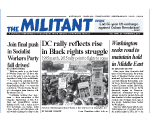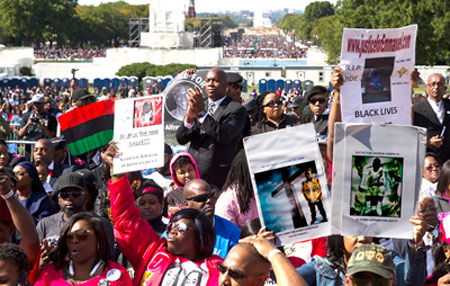In one of the largest political events this year, more than 100,000 people turned out in Washington, D.C., Oct. 10 for the “Justice or Else” rally, marking the 20th anniversary of the Million Man March. Like that historic rally, it highlighted what African-Americans face in the United States.
Louis Farrakhan called both actions, but participation went way beyond the followers of his Nation of Islam.
The hundreds of thousands of Black men and youth who packed the National Mall in 1995, overwhelmingly working people, were demonstrating Black pride and rejection of an image in society of Black men as violent criminals and an irresponsible “underclass.”
That outpouring reflected the irreversible gains won with the victory of the mass working-class led movement that overthrew Jim Crow segregation in the 1950s and ’60s. This strengthened the working class and transformed the possibilities for united action among toilers across the racist divisions generated by the capitalist rulers.
At the same time it registered widespread anger among African-Americans at what they continue to face. The turnout was fueled by the offensive of the bosses and government already underway against the wages, social conditions and democratic rights of working people.
The rally posed — though it offered no solution to — the social effects of centuries of slavery and racist oppression on the Black family. In 1965 Daniel Moynihan, then an adviser in the administration of President Lyndon Johnson, drafted a paper saying the government was underestimating the damage done to Black families by “three centuries of sometimes unimaginable mistreatment.” His proposals, not included in the report, included establishing a guaranteed minimum income and government jobs program.
On the heels of the overthrow of Jim Crow, the working class won some victories in establishing affirmative action and other programs aimed at closing the gap in economic conditions facing African-Americans. However, the propertied ruling families refused to divert resources from their profits to underwrite the requisite expansion of jobs, wages and social programs.
Impact of ruling-class offensive
Instead they opened wide their prison gates. From the mid-1970s to the mid-’90s, the incarceration rate quadrupled, from 150 to 600 per 100,000.The soaring rates disproportionately affected African-American men, as both the federal and state governments adopted a raft of laws under the rubric of a “war on drugs” and draconian mandatory minimum sentencing laws. The unemployment rate for workers who are Black was roughly double the national average. And just days before the rally Jonny Gammage, a Black businessman, was beaten to death by cops in a suburb of Pittsburgh.
In the 20 years since the Million Man March these trends have continued. The expansion of the prison system accelerated throughout the presidencies of William Clinton and George W. Bush to the point where the U.S. today has the highest incarceration rate in the world, even with a slight decline in the last couple of years. The number of workers behind bars grew 500 percent between 1980 and 2010. The incarceration rate for Caucasian men in their 20s tripled. The effect on African-Americans was even higher.
Another hallmark of the Clinton presidency was the 1996 repeal of Aid to Families with Dependent Children — the first time an entire category of working people, single mothers and their children, were removed from protections under the Social Security Act.
During his 2008 presidential campaign Barack Obama said that while he worried at the time that ending AFDC would have disastrous results, he had become “absolutely convinced” that Clinton’s “welfare reform” had to remain “a centerpiece of any social policy.”
But far from having productive jobs at good wages, by 2005 only half of those pushed off AFDC were employed at all, forced into low-paying, nonunion jobs. The 50 percent of former AFDC recipients who were Black and unemployed had fallen more than 30 percent further below the official government poverty line than they were in 1999. And this was before the deep 2008 recession that sent unemployment skyrocketing.
Bourgeois politicians from Clinton to Obama, offered sanctimonious lectures to workers who are Black on how to be better parents, while pushing all social responsibility onto the individual family. They obfuscate the fact that capitalist property relations are the root of so much individual and “family” misery today.
Rally marked by rise in resistance
The Justice or Else rally was marked by the recent rise in resistance to these conditions. The explosion of Black Lives Matter struggles centered on the brutal treatment meted out by the cops has had an impact. The rulers have been forced to take steps to rein in their police. Killer cops have been hit by firings, indictment and jail. It was these struggles, alongside the continued changes in attitudes won by the massive battles for Black rights in the 1950s and ’60s, that led to the victory this summer when the Confederate battle flag in South Carolina was brought down.In California and elsewhere, tens of thousands of workers behind bars have organized hunger strikes and other protests against solitary confinement and other abusive conditions, forging unity in action among inmates who are Black, Latino and Caucasian, and asserting their humanity.
These struggles have also increased pressure on the government to change some of the most egregious policies on incarceration and the prisons. On Oct. 6, for example, it was reported that the Justice Department plans to release 6,000 people imprisoned on nonviolent drug charges, the largest one-time release of federal prisoners to date. Prominent figures in both the Republican and Democratic parties have called for reducing mandatory minimum sentences and other steps to reduce the number of Blacks and others in prison.
The fights against police brutality, mass incarceration and prison conditions have intertwined with struggles to raise the minimum wage and for unionization.
Shawnette Richardson, a McDonald’s worker active in the Fight for $15 in Brooklyn, and her 18-year-old son joined a group of fast-food workers and others involved in Black Lives Matter protests to travel to Washington. She told the New York Daily News that beyond the fight to raise wages, “my children, all children, deserve to be respected and safe. And I deserve not to fret every time my son steps out of the house.” These fights are “one and the same,” she said.
The organizers of the rally, starting with Nation of Islam leader Farrakhan, presented no road forward — just various pro-capitalist “self-help” proposals that the Nation has promoted from the beginning.
But many who came felt the sense of pride and confidence that comes from struggle and were strengthened by coming together with others like them.
Related articles:
Chicago protest demands: ‘Fire cop who killed Rekia Boyd’
‘We want truth about what happened to our son’
|
Printer-friendly version of this article |















